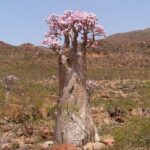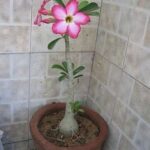Desert rose: origin and properties
Adenium is a genus of plants naturally occurring in parts of Africa and the Arabian Peninsula. It belongs to the dogbane family (Apocynaceae) and, like other members of this group, contains a characteristic milky sap. The desert rose is a succulent that stores water in a so-called caudex. This is the term used to describe the type of swollen trunk between the root and the stems. The caudex can be shaped and developed in different ways, making it very decorative.
The swollen trunk makes the evergreen shrub appear more tree-like. In nature it can reach a height of up to five meters, but indoors the Adenium houseplant can reach between 30 cm and 3 meters in height.
The evergreen leaves of this desert rose are oval, thick, and dark green. But not only their interesting stem shapes and evergreen leaves fascinate us, their delicate flowers also form a real contrast. Desert rose plants begin blooming in April through July and can bloom in a variety of colors, from white to purple. As a result of breeding, some varieties will even flower with double flowers.
The most beautiful Adenium species and varieties
There is still disagreement about the exact number of desert rose species and cultivars. Some believe it is just one species of desert rose, namely Adenium obesum. All other desert rose species, following this line of thinking, are subspecies. However, others believe that the different species are their own distinct species. Whether they are distinct species or subspecies, all of the following desert roses are perfect for keeping as decorative houseplants.
Adenium obesum: The common desert rose, as mentioned above, is considered by some to be the true desert rose. The flowers of this species come in many colors. Typically, the inside of the flower is lighter than the outside, creating a nice gradient effect.
Common desert roses in the stone desert
Adenium arabic: Adenium arabic, also known as elephant foot or adan bush, looks very similar to Adenium obesum, but is smaller in stature. If you want to cultivate a desert rose as a bonsai, this species is the best choice.
Adan bush bonsai tree
Adenium multiflorum: As the name suggests, this desert rose species flowers particularly impressively. It is also more compact than other strains; in the wild it only grows up to three meters high.
Pink-red flowering Adenium multiflorum
Desert Rose ‘Snow White’: This stunning species of desert rose has rich white blooms and double flowers.
Snow-white desert rose double flower
Desert Rose ‘Golden Dragon’: The desert rose ‘Golden Dragon’ forms unusual yellow flowers.
Golden dragon desert rose yellow flower
Cultivation, location and soil
Adenium is a very undemanding, easy-care houseplant. You don’t have to buy a ready-made plant to enjoy your own desert rose; It is also possible to grow the desert rose from seed. When propagating from seeds, the caudex of small plants is usually better developed than in offspring propagated by cuttings.
To grow desert roses from seed, spread the desert rose seeds out on a growing medium in spring and cover them with soil. This layer should be a maximum of one centimeter thick. Keep the soil moist and place the pot in a warm and bright place with temperatures around 20 to 25°C. The first seedlings can appear after a week and are then transplanted within a few weeks. When the first pairs of leaves appear, you can transplant the small desert roses. Cover the part of the caudex where most of the roots are with soil. You can also leave a slightly larger part of the caudex at the surface and simply cut off the fine upper roots. A shallow pot encourages a larger caudex and prevents the plant from growing too tall.
Summer desert rose outdoors
The desert rose needs a warm and very sunny spot to thrive, south facing windows are perfect for these plants as long as you water them regularly. Temperatures around 20 °C are ideal, but can also tolerate warmer temperatures. Even dry air is no problem for these desert plants. As soon as summer temperatures hit double digits, you can set the desert
 TopsDecor.com Home Decor Ideas
TopsDecor.com Home Decor Ideas






























































